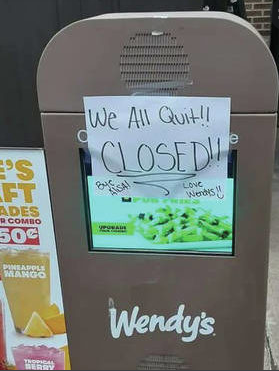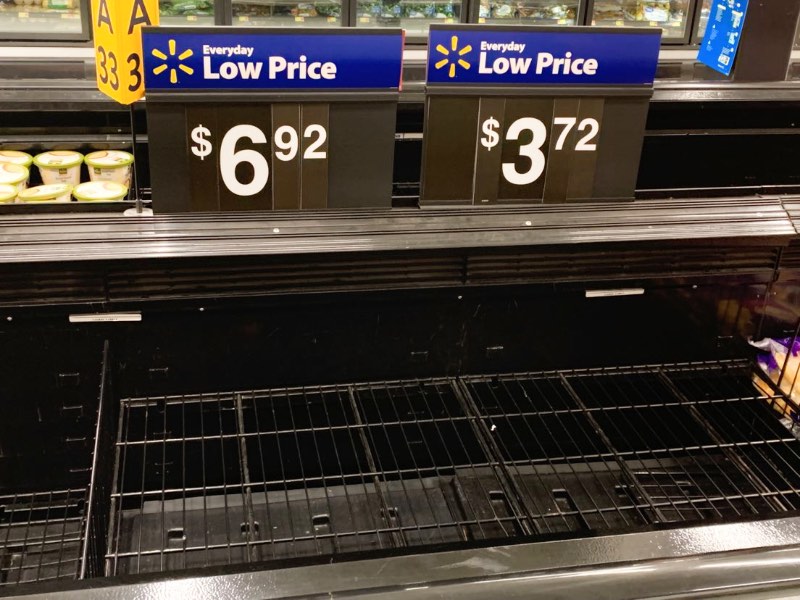Food supply chain shortage returning
Credit: Ari'el Abbott
Empty dairy section at Walmart-Mart on Gull Road.
March 14, 2022
Walking into Walmart, looking at the dairy section for some orange juice, I was surprised to see that most of the shelves were completely empty.
Walking around the store reminded me of two years ago when every store was suffering from a food shortage as well. All around the country, stores are beginning to resemble the spring of 2020 where many of the shelves in grocery stores are empty.
Senior James Baldwin, employee at Town & Country Supermarket has noticed these shortages and said, “At my store, it isn’t a choice of wanting to actually limit the amount our customers can get, especially while we’re in a pandemic, but with fewer of the products, we have the need to keep our store running is just as important as limiting the number of items you can buy.”
Farmers have plenty of product, but lack of employees leave empty shelves
Since the beginning of the pandemic, employees have been departing from their jobs in mass numbers.
Megan Leonhardt from Fortune analyzed that “the industry logged nearly a million quits—987,000—with most coming from accommodation and food service workers.”
 Signs have been taped to the speakers of fast-food restaurant drive-throughs, showing that all of the workers have quit and that the restaurant is closed until further notice.
Signs have been taped to the speakers of fast-food restaurant drive-throughs, showing that all of the workers have quit and that the restaurant is closed until further notice.
Union workers have been working towards a higher minimum wage since before the start of the pandemic, and with the rise of the COVID-19 omicron variant cases, the pay increase has become more urgent.
“With the amount of inflation that’s happening right now and being in a pandemic, 10 to 12 dollars pay is not going to help with paying the bills every month. The need for an increase in minimum wage can help with poverty and improve the work ethic,” said senior food service entrepreneur Sarah Harris.
There is one state currently that has $15 an hour for minimum wage, California, but as we get further into 2022, there are expected to be more states headed for the minimum wage raise within the next four years.
According to GovDocs, the states who are on their way to raising their minimum wage are Connecticut, Delaware, Florida, Illinois, Maryland, Massachusetts, New Jersey, Rhode Island, Virginia, and Washington D.C. these states beginning from January through July of 2022.
With the increase of minimum wage, employers will be able to keep and recruit more workers to address the national food supply chain shortage.
“I feel like right now the minimum wage being increased to $15 will help so many people with bills, gas, and human problems that only money can solve. It’s not a want at this point, it’s a very much needed upgrade,” said senior Mackenzie Carpenter, an employee at Panda Express.
Food workers have one of the lowest-paid jobs in the industry
The food industry is a $9 trillion industry, but usually, no one gets paid any more than $25 an hour and usually significantly lower than that. The fast-food industry is a $647.7 billion industry and $256.03 billion in the United States alone. These both are huge industries that don’t pay their fair share to the employees. At most restaurants, working long hours in a hot environment with a mask on and only being paid ten dollars an hour isn’t the ideal job, even in fast food.
“The working conditions in fast-food restaurants compared to other industries are a dramatic decrease in how employees are treated and paid. I don’t agree that having companies who make millions of dollars every year, get away with only paying their employees the bare minimum,” said employee at Biggby Coffee, junior Javon Harris.
This massive industry is taking advantage of their workers leaving most workers struggling when their paycheck arrives. According to the UC Berkeley Labor Center, “one in five families with a member holding a fast-food job has an income below the poverty line.”
Unemployment rate increases since the start of the pandemic
The amount of people who have not been working has been steadily increasing since the beginning of the pandemic, with about 6.3 million people currently unemployed according to the Bureau of Labor Statistics.
It hasn’t always been common to see “now hiring” signs in the windows of restaurants, but within the past few years, I have seen them more than usual. I’ve wondered why, even after months passing, the signs are still up.
“Ever since coming out of quarantine, the amount of people who actually want to work has decreased. Everyone is so used to being able to wake up and live off the funds given by the government to the point where they don’t want to go back to actually having to work the traditional eight hours for their full-time jobs,” said senior Zamiah Wilson, employee at Jimmy John’s.
Due to not having enough employees, the food supply chain shortage will continue to leave empty shelves in grocery stores until the labor shortage stops.
Trucking and shipping is short-staffed
Truck drivers play a key role in the United States economy. According to the Truck Driver Institute, “they move approximately 70% of the nation’s freight each year. That amounts to about 671 billion dollars worth of goods annually.”
The United States has a shortage of around 80 thousand drivers which is causing chaos to stir in the U.S. supply chain.
According to NPR, “the ATA [American Trucking Association] says that more than 70 percent of goods consumed in the U.S. are moved by truck, but the industry needs to hire almost 900,000 more drivers to meet rising demand.”
The ATA analysis also shows that within the last 15 years, the industry has had some challenges with driver shortages. In the course of the Great Recession, merchandise volume has decreased, reducing the number of drivers.
The main reason that truck drivers are struggling to grow their employment is due to the lifestyle of a truck driver being less ideal to average Americans. Being a driver means you are going to spend hours upon hours on the roads.
According to “Truckers are back, a good sign for economic recovery” on The Counter website, truck drivers are the source of how products are transferred from companies and slaughterhouses.
Are you looking for food banks? Here’s where to check:
Kalamazoo Loaves and Fishes
901 Portage Street
Douglass Community Association (through Loaves and Fishes)
1000 W. Patterson Street
Haven Church Food Pantry
5350 N. Sprinkle Road
Centerpoint Church – Loaves and Fishes
2345 North 10th Street
Dream Center
1122 Portage Street
Kalamazoo Gospel Mission
448 N. Burdick Street
Eastside Neighborhood Association
1301 E. Main Street
Sunnyside United Methodist Church – Loaves and Fishes
2800 Gull Road
Ministry with Community
500 North Edwards Street
Fresh Fire AME Church
2508 Gull Road
Westwood Neighborhood Food Pantry
538 Nicholas Road












